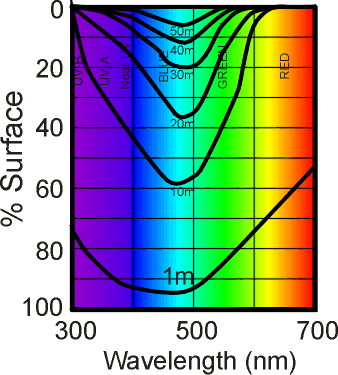
Questions
- How much UV does it take to cause irreparable damage to the developing organism?
- Are there parts of the cell cycle or development that are more susceptible?
- Are sperm or eggs more susceptible to UV damage? What happens to the sperm, eggs, embryos and larvae if damage does occur?
- [Advanced Question] Which form of UV - A (long), B (short) or C (shortest) causes the most harm? (note: the ozone layer prevents most UV-C from making it to the earth's surface)
- [Advanced Question] Egg color varies with species and diet, from pale yellow to dark red. Does color play a role in UV protection? (L. pictus will eat potatoes and carrots, which lighten or darken eggs produced, respectively, over a few weeks time.). (A. punctulata has dark red eggs)
Procedures
Your options are highly dependent on what you have available. Many physics and chemistry labs have hand held UV lamps with short and long wave bulbs/filters. These lamps are low wattage, but they can be used if placed sufficiently close to the samples being irradiated. (i.e. directly on top of an open petri dish of eggs or sperm)
The UV source could also be sunlight, IF you provide some means to control the temperature affects as well. Ice and water baths could be used to help control temperature.
A setup for a "typical" experiment might look like this when using a 4 watt filtered lamp(set to short wave):
Exposure Time → |
Control |
1 minutes |
2 minutes |
5 minutes |
1 cm from dish |
|
|
|
|
5 cm from dish |
|
|
|
|
10 cm from dish |
|
|
|
|
Fudge factors for lamps of differing wattage:
Wattage |
4 |
6 |
8 |
15 |
40 |
Factor |
1.0 |
0.7 |
0.5 |
0.35 |
0.1 |
To use, multiply the times in the example above by the factor indicated. These "fudge factors" are only a starting point. Shape of lamp, type of filter, kind of lamp all affect results. You can also vary the distance from the lamp to the sample. Here the relationship follows the "inverse square law", meaning the light decreases at the square of the distance. If your 40 watt bulb is long instead of compact, then the factor will be more like 0.5
After exposure, place one set of dishes in a light tight box or cover with aluminum foil (or one group of students does this set). The second set is left out in room light (second set of students do these). It is important that both sets are at the same temperature. All animals except mammals have a light activated repair mechanism for UV-DNA damage. You could experiment further with colored filters to determine the wavelength and intensity of light needed by the repair mechanism.
UV light works on DNA to cause thymine pairs to cross-link. This then causes a "misread" when the sequence is duplicated.
-T-G-C-A-T-T-A-G-G-C-T-A-A-C- AFTER -T-G-C-A-T=T-A-G-G-C-T-A-A-C- | | | | | | | | | | | | | | UV → | | | | | | | | | | -A-C-G-T-A-A-T-C-C-G-A-T-T-G- BECOMES -A-C-G-T-A-A-T-C-C-G-A-T=T-G-
Why would this not happen in RNA?
Strong enough UV will affect proteins as well. One particularly sensitive protein is also very important in cell reproduction, Tubulin. Tubulin normally polymerizes to become microtubules. What are microtubules and what is their role?
Back to the experiment. What percentage fertilize? When you notice that the control group has divided, what percentage of the other groups have divided? You might want to let some embryos from each group go overnight and compare to the controls.
